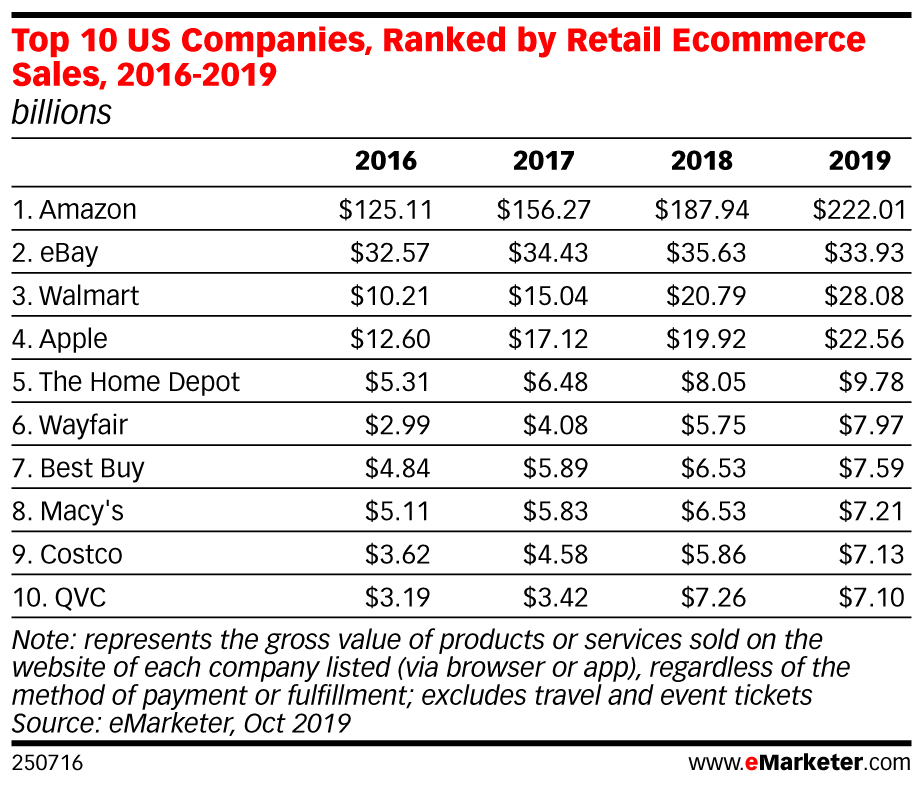Wayfair – The E-Commerce Challenger

Wayfair is an e-commerce company that specialized in furniture and home-goods. Founded in 2002, it is one of the largest e-commerce companies in the United States with $8 billion of sales in 2018. The company has experienced high growth, and is not yet profitable [1].
Since its beginning, data has been fundamental to the company’s value creation strategy. According co-founder Steve Conine, Wayfair amasses large amounts of data: “On average, we capture and store four terabytes of data every day and over the course of a year, we track approximately 40 billion customer actions on our site” [2]. In order to take care of that data, the company employs a team of 120 data scientists. However, data has been democratized across the organization; it can be accessed and used regardless of whether an employee works in marketing, logistics, or engineering [3].
Data has allowed the company to better execute on its strategy and standout against competitors such as Amazon, through improved personalization and supply chain management.
Personalization – What Furniture Matches your Room?
Wayfair provides its customers a personalized shopping experience. As other technology companies, it uses data to target advertisements, provide product recommendations, and power its search engine.
However, Wayfair’s recommendation engine is unique in the way it uses imagery to inform recommendations. Product aesthetics is particularly relevant to home-goods. For example, customers may be interested in purchasing a bookcase that matches their living room. Wayfair uses product images of prior purchases and items browsed as inputs in its AI model. In turn, the model learns which products are complementary and recommends them to customers. As a result, Wayfair’s product recommendations are tailored to the unique aesthetic tastes of its customers [4].
In addition to its recommendation engine, images have also helped to optimize the company’s search capabilities. Wayfair has created a visual search feature called “Search with Photo.” Through this feature, users can take a picture of an item they like, upload it to the website, and Wayfair will employ its big data capabilities to recommend visually similar items [3].
The value created by Wayfair’s data-centric, visual search and recommendation capabilities is best summed up by co-founder Steve Conine:
“We knew that everyone has a unique vision for their home and ideas and inspiration can come from anywhere. A sofa in a friend’s house, a Pinterest board…And while finding a look you love may be easy, finding the specific products to bring that look to life can be time-consuming and require a lot of searching. With visual search, shoppers can now search for and find a particular product or style instantly” [3].
Supply Chain Management
Unlike other retail companies, Wayfair does not store products in its warehouses. Instead, products are shipped directly from the supplier to the consumer. This elaborate supply chain is enabled by data communication and analysis. Suppliers upload information regarding their stock to the server. An algorithm uses the inventory data, defines the best way to ship an item depending on location and product characteristics, and calculates the shipping time in order to ultimately enable an order fulfillment with a 98% success rate [5].
Wayfair has been able to use data to create a personalized, curated shopping experience for its consumers and to ensure the timely delivery of bulky and heavy products. However, what has kept competitors such as Amazon from excelling in these capabilities? Wayfair has been better equipped to compete in the home-goods category due to its large data set in this category [6]. Yet, Wayfair faces the potential of Amazon growing its furniture offering (and data) to match its own.
[1] “Wayfair, The Internet’S Massive Online Furniture Store, Explained”. 2019. Vox. https://www.vox.com/2019/8/28/20833645/wayfair-many-brands-websites.
[2] “Data Science Investments A “Core Driver” Of Wayfair’s E-Commerce Success”. 2019. RIS News. https://risnews.com/data-science-investments-core-driver-wayfairs-e-commerce-success.
[3] DeNisco-Rayome, Alison. 2019. “How Wayfair Used Big Data And Omnichannel Retail To Transform Shopping | Zdnet”. Zdnet. https://www.zdnet.com/article/how-wayfair-used-big-data-and-omnichannel-retail-to-transform-shopping/.
[4] Staff, VB. 2019. “Wayfair’S AI-Powered Recommendation Engine Will Soon Be Table Stakes (VB Live)”. Venturebeat. https://venturebeat.com/2018/02/16/ai-powered-customer-engagement-isnt-optional-anymore-vb-live-2/.
[5] “Wayfair | Online Home Design & Furniture Retailer”. 2019. Cleverism. https://www.cleverism.com/wayfair-online-home-design-furniture-retailer/.
[6] “Wayfair Takes On Pinterest With Its Own Visual Search Engine For Home Furnishings – Techcrunch”. 2019. Techcrunch. https://techcrunch.com/2017/05/16/wayfair-takes-on-pinterest-with-its-own-visual-search-engine-for-home-furnishings/.







While I like the fact that Wayfair is using big data to automate some of its processes, I’m not convinced about their ability to leverage big data to improve its operations. As most recent financial analysts show, the company has been unsuccessful in growing its consumer base as the market for furniture is extremely cyclical and vulnerable to economic cycles. After working at Walmart Labs’s strategy team, I quickly learned that last-mile delivery and operations in ecommerce are incredibly expensive, and that the unit economics are hard to make profitable. Maybe Wayfair should focus on adding more value-added services to abate the costs of sending its furniture, and use big data analytics to offer personalized solutions?
Interesting post! I think Wayfair should absolutely be worried about Amazon moving into furniture categories and amassing large amounts of data. That diminishes Wayfair’s edge significantly. However – I like the company’s emphasis on personalization. It seems to me that creating innovative shopping experiences, and advanced tools that help customers make purchasing decisions (beyond the now ubiquitous “recommended for you” and “you may also like” product recommendations), is a powerful way to keep customers loyal to your platform.